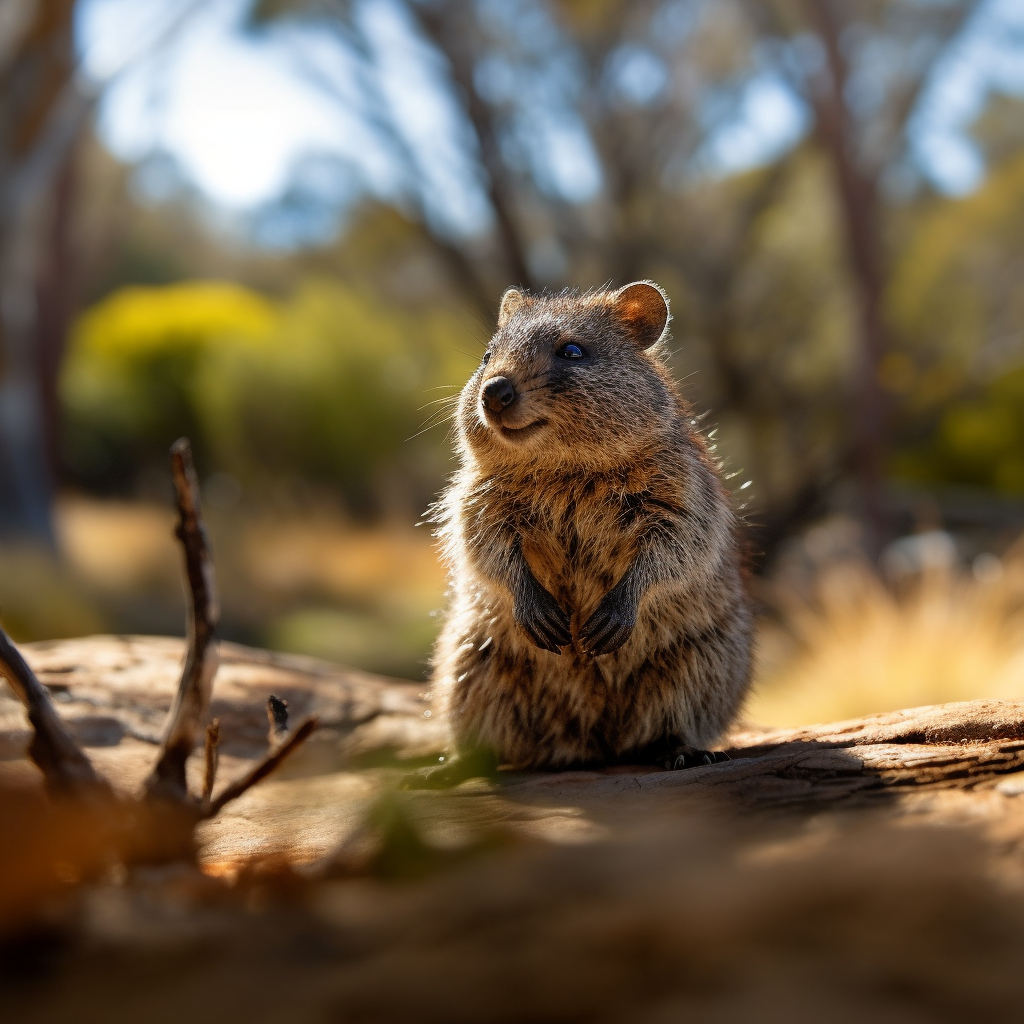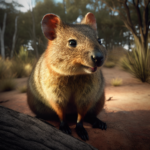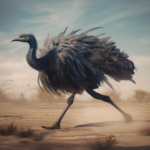The quokka and the chipmunk are two adorable creatures that often capture the hearts of animal lovers. While they may share some similarities in appearance, they belong to different parts of the world and have distinct characteristics. The quokka is a small marsupial native to Western Australia, known for its friendly and photogenic nature. On the other hand, the chipmunk is a small rodent found in North America, known for its energetic behavior and love for nuts. In this article, we will explore the differences and similarities between these two fascinating creatures, shedding light on their habitats, physical features, behaviors, and more. So, let’s dive in and discover the unique qualities of the quokka and the chipmunk!
Key Takeaways
- Quokkas are small marsupials found in Australia, while chipmunks are small rodents found in North America.
- Quokkas have a friendly and curious nature, often approaching humans, while chipmunks are more skittish and tend to avoid human interaction.
- Quokkas have a rounder body shape and a short tail, while chipmunks have a slender body and a long, bushy tail.
- Quokkas are herbivores, primarily feeding on grasses and leaves, while chipmunks are omnivores, eating a variety of nuts, seeds, fruits, and insects.
- Both quokkas and chipmunks are known for their adorable appearance and are popular subjects for wildlife photography.
Understanding Quokkas: The Smiling Marsupials

A. Origin and Habitat: Where Quokkas are Found
Quokkas, those adorable and photogenic creatures, are native to the beautiful continent of Australia. Specifically, they can be found in the southwestern part of the country, primarily in Western Australia. These small marsupials inhabit a variety of environments, including forests, scrublands, and coastal areas. They have a preference for dense vegetation, which provides them with both shelter and a diverse range of food sources.
Quokkas are known to thrive on several islands off the coast of Western Australia, such as Rottnest Island and Bald Island. The absence of predators on these islands has allowed the quokka population to flourish. In fact, Rottnest Island is particularly famous for its large quokka population, attracting tourists from all over the world who are eager to capture a selfie with these smiling marsupials.
B. The Quokka Smile: Unraveling the Mystery
One of the most intriguing aspects of quokkas is their seemingly perpetual smile. Their upturned mouths give them a perpetually cheerful appearance, earning them the title of “the happiest animal on Earth.” But what is the secret behind their smile?
Contrary to popular belief, the quokka smile is not an expression of happiness or joy. It is simply a result of their unique facial structure. Quokkas have a short snout and a high-set mouth, which naturally gives them an upturned appearance. This distinctive feature, combined with their round cheeks and large, dark eyes, creates the illusion of a smile.
While quokkas may not actually be smiling, their friendly and curious nature certainly adds to their charm. They are known to approach humans without fear, making them a delight to encounter in the wild.
C. Quokka vs Kangaroo: A Comparative Analysis
Quokkas and kangaroos are both marsupials, but they belong to different genera. While kangaroos are part of the Macropus genus, quokkas are classified under the Setonix genus. Despite their differences, there are a few similarities between these two Australian natives.
Both quokkas and kangaroos are herbivores, feeding on a diet primarily composed of grasses, leaves, and other plant matter. Additionally, both species have a pouch to carry and protect their young. However, the size and shape of their pouches differ significantly. Kangaroos have a large, forward-facing pouch, while quokkas have a smaller, rear-facing pouch.
In terms of size, kangaroos are much larger than quokkas. Adult kangaroos can reach heights of up to 6 feet and weigh over 200 pounds, while quokkas are only about the size of a domestic cat, measuring around 16-21 inches in length and weighing between 6-11 pounds.
D. Quokka vs Capybara: Distinguishing Features
Although quokkas and capybaras share a similar size and are both herbivorous, they belong to different taxonomic families. Quokkas are marsupials, while capybaras are the largest rodents in the world. Let’s explore some of the distinguishing features between these two fascinating creatures.
One of the most noticeable differences is their habitat. Quokkas are found exclusively in Australia, while capybaras inhabit parts of South America, including countries like Brazil, Venezuela, and Colombia. Quokkas prefer a variety of environments, including forests and coastal areas, whereas capybaras thrive in wetlands, marshes, and riverbanks.
In terms of appearance, quokkas have a rounder and more compact body shape, while capybaras have a longer and more elongated body. Quokkas also have a distinctive upturned mouth, giving them a perpetually smiling expression, whereas capybaras have a more neutral facial expression.
Another key difference lies in their reproductive strategies. Quokkas are marsupials, meaning they give birth to relatively undeveloped young, which then continue to develop in their mother’s pouch. On the other hand, capybaras are rodents and give birth to fully developed young.
E. Quokka vs Squirrel: Is Quokka a Squirrel?
While both quokkas and squirrels are small mammals, they belong to different taxonomic families. Quokkas are marsupials, whereas squirrels are rodents. Let’s delve into the differences between these two adorable creatures.
One of the most apparent distinctions is their geographical distribution. Quokkas are native to Australia, particularly Western Australia, while squirrels are commonly found in various parts of the world, including North America, Europe, and Asia.
In terms of physical appearance, quokkas have a stockier build with short legs, while squirrels have a more slender body and longer limbs. Quokkas also have a unique upturned mouth, giving them a smile-like expression, whereas squirrels have a more neutral facial appearance.
Another significant difference lies in their diet. Quokkas are herbivores, primarily feeding on grasses, leaves, and other plant matter. Squirrels, on the other hand, are omnivores, consuming a wide range of foods, including nuts, seeds, fruits, and even small insects.
F. Quokka vs Quoll: A Close Look at the Differences
Quokkas and quolls may sound similar, but they are distinct species with notable differences. Quokkas belong to the marsupial family, while quolls are carnivorous marsupials. Let’s explore the disparities between these two fascinating creatures.
One of the most significant differences lies in their diet. Quokkas are herbivores, primarily feeding on vegetation, while quolls are carnivores, preying on small mammals, birds, reptiles, and insects. This divergence in diet is reflected in their dentition, with quokkas having flat molars for grinding plant matter and quolls possessing sharp teeth for tearing flesh.
Another distinguishing feature is their size. Quokkas are relatively small, measuring around 16-21 inches in length and weighing between 6-11 pounds. Quolls, on the other hand, are larger, with some species reaching lengths of up to 30 inches and weighing up to 10 pounds.
Quokkas and quolls also differ in terms of their habitat. Quokkas are primarily found in Western Australia, inhabiting a range of environments, including forests, scrublands, and coastal areas. Quolls, on the other hand, have a broader distribution, with various species found in Australia, New Guinea, and Tasmania.
G. The Unique Anatomy of Quokkas: Do Quokkas Have Pouches?
As marsupials, quokkas possess a unique anatomical feature that sets them apart from other mammals: a pouch. However, unlike kangaroos and other marsupials with forward-facing pouches, quokkas have a rear-facing pouch.
The quokka pouch serves as a protective space for their young, known as joeys. After a gestation period of approximately one month, the tiny, underdeveloped joeys crawl into the mother’s pouch, where they attach themselves to a teat and continue to grow and develop. The pouch provides a safe and nurturing environment for the joeys until they are ready to venture out into the world.
It’s worth noting that the quokka pouch is not as prominent as the pouches of other marsupials. This is due to the relatively short gestation period and the fact that quokkas give birth to relatively well-developed young compared to other marsupials.
H. Are Quokkas Rodents? Debunking Misconceptions
Despite their small size and rodent-like appearance, quokkas are not rodents. They are, in fact, marsupials belonging to the same family as kangaroos, wallabies, and koalas. The confusion may arise from their physical characteristics, such as their small stature, rounded body shape, and short legs.
Rodents, on the other hand, belong to the order Rodentia, which includes animals like mice, rats, squirrels, and beavers. These creatures have distinct characteristics, including continuously growing incisors and a different reproductive system compared to marsupials.
While quokkas and rodents may share some superficial similarities, it is important to recognize their taxonomic differences. Quokkas are unique marsupials that have evolved to thrive in their specific habitats, bringing joy to those fortunate enough to encounter them in the wild.
In this section, we’ve explored various aspects of quokkas, including their origin and habitat, their distinctive smile, comparisons with other animals such as kangaroos, capybaras, squirrels, and quolls, their unique anatomy, and debunking misconceptions about them being rodents. Quokkas truly are fascinating creatures, and their presence in the animal kingdom adds to the diversity and wonder of our natural world.
Chipmunks: The Striped Scurriers

Chipmunks are small, adorable creatures that are often found scurrying around in forests and woodlands. With their distinctive stripes and lively personalities, chipmunks have captured the hearts of many nature enthusiasts. In this section, we will explore the key differences between chipmunks and squirrels, understand their aggressive behavior, discover animals similar to chipmunks, and embark on a fun exploration of chipmunk species.
A. Chipmunk vs Squirrel: Identifying Key Differences
Chipmunks and squirrels may share some similarities in appearance, but there are several key differences that set them apart. Here are a few characteristics that can help you distinguish between the two:
-
Size: Chipmunks are generally smaller than squirrels, measuring around 5 to 6 inches in length, excluding their bushy tails. Squirrels, on the other hand, can grow up to 12 inches or more, including their tails.
-
Stripes: One of the most noticeable features of chipmunks is their striped fur. These stripes run along their backs, from their heads to their tails. Squirrels, on the other hand, typically have a more uniform coloration.
-
Cheek Pouches: Chipmunks have expandable cheek pouches that they use to store and carry food. These pouches can stretch to three times the size of their heads! Squirrels, on the other hand, do not have such prominent cheek pouches.
-
Behavior: Chipmunks are known for their ground-dwelling habits, while squirrels are more commonly seen climbing trees. Chipmunks are also more solitary creatures, while squirrels are often seen in groups or colonies.
B. When Chipmunks Attack: Understanding Aggressive Behavior
While chipmunks are generally docile and non-aggressive creatures, there are instances where they may exhibit aggressive behavior. This behavior is usually a result of feeling threatened or defending their territory. Here are a few things to keep in mind:
-
Vocalizations: When chipmunks feel threatened, they may emit high-pitched chirping sounds or loud chattering noises. These vocalizations serve as a warning to potential intruders.
-
Biting: In extreme cases, chipmunks may resort to biting if they feel cornered or provoked. It’s important to remember that chipmunks are wild animals and should be observed from a safe distance to avoid any potential harm.
-
Territoriality: Chipmunks are territorial creatures and may become aggressive towards other chipmunks encroaching on their territory. This behavior is more commonly observed during the breeding season.
C. What Animal is Similar to a Chipmunk?
If you’re wondering what other animal is similar to a chipmunk, look no further than the ground squirrel. Ground squirrels share many similarities with chipmunks, including their small size, striped fur, and ground-dwelling habits. However, ground squirrels lack the expandable cheek pouches that chipmunks possess.
D. Which Chipmunk am I? A Fun Exploration of Chipmunk Species
Chipmunks belong to the family Sciuridae, which includes several different species. Let’s take a closer look at some of the most common chipmunk species:
| Species | Habitat | Range | | ——————– | ———————————– | ———————————– | | Eastern Chipmunk | Forests, woodlands, and gardens | Eastern North America | | Least Chipmunk | Grasslands, shrublands, and forests | Western North America | | Siberian Chipmunk | Forests and gardens | Siberia and parts of Asia | | Yellow-pine Chipmunk | Coniferous forests and mountainsides | Western North America and Mexico |
Each chipmunk species has its own unique characteristics and adaptations that allow them to thrive in their respective habitats. Exploring the diversity of chipmunk species can be a fascinating journey into the world of these charming creatures.
In conclusion, chipmunks are fascinating animals with their striped fur, cheek pouches, and lively behavior. While they may resemble squirrels, chipmunks have distinct characteristics that set them apart. Understanding their behavior and identifying their species can enhance our appreciation for these delightful creatures that inhabit forests and woodlands across the world.
Quokka vs Chipmunk: A Detailed Comparison

A. Physical Differences: Size, Appearance, and More
When comparing quokkas and chipmunks, it’s evident that these two creatures belong to different animal families and have distinct physical characteristics.
Quokka Characteristics
Quokkas are small marsupials native to Australia. They have a round face, short ears, and a compact body. On average, quokkas measure about 16 inches (40 cm) in length and weigh between 6.6 to 11 pounds (3 to 5 kg). Their fur is coarse and varies in color, ranging from brown to gray. One of the most notable features of quokkas is their friendly and seemingly smiling expression, which has earned them the title of “the happiest animal on Earth.”
Chipmunk Features
On the other hand, chipmunks are rodents found in North America. They have a slender body, a bushy tail, and prominent cheek pouches. Chipmunks are smaller than quokkas, measuring around 5 to 6 inches (13 to 15 cm) in length and weighing between 1 to 5 ounces (28 to 142 grams). Their fur is soft and typically striped, with colors ranging from reddish-brown to gray. Chipmunks have a more alert and skittish appearance compared to the friendly quokkas.
B. Behavioral Differences: From Smiling Quokkas to Attacking Chipmunks
Apart from their physical dissimilarities, quokkas and chipmunks also exhibit contrasting behaviors.
Quokka Behavior
Quokkas are known for their friendly and curious nature. They are not afraid of humans and often approach them, leading to the famous “quokka selfies” that have become popular on social media. Quokkas are primarily herbivores, feeding on grasses, leaves, and other vegetation. They are mostly active during the day and spend their time foraging for food or resting in shaded areas. Despite their gentle demeanor, it’s important to remember that quokkas are wild animals and should be observed from a respectful distance.
Chipmunk Behavior
In contrast, chipmunks are more cautious and tend to be skittish around humans. They are known for their quick movements and agility. Chipmunks are omnivores, with a diet that includes nuts, seeds, berries, insects, and even small vertebrates. They are diurnal creatures, meaning they are most active during the day. Chipmunks are known for their burrowing behavior, creating intricate underground tunnels and chambers where they store food and seek shelter.
C. Habitat and Lifestyle: Comparing Environments and Behaviors
Quokkas and chipmunks inhabit different regions and have distinct lifestyles.
Quokka Habitat
Quokkas are endemic to Western Australia, specifically found on Rottnest Island and a few other nearby islands. They prefer dense vegetation, including forests, shrublands, and grasslands. Quokkas are excellent climbers and can be found in trees or on the ground. Due to their limited range, quokkas face habitat loss and predation from introduced species, making conservation efforts crucial for their survival.
Chipmunk Habitat
Chipmunks, on the other hand, are found throughout North America, from Canada to Mexico. They inhabit a variety of environments, including forests, woodlands, and suburban areas. Chipmunks are skilled climbers and spend a significant amount of time in trees. They also construct complex burrow systems, which serve as their homes and provide protection from predators and harsh weather conditions.
D. Survival Strategies: How Quokkas and Chipmunks Adapt to Their Environment
Quokkas and chipmunks have developed unique survival strategies to thrive in their respective habitats.
Quokka Adaptations
Quokkas have adapted to their environment by evolving specialized teeth for efficiently consuming vegetation. Their teeth continuously grow throughout their lives, allowing them to wear down from constant chewing. Additionally, quokkas have strong hind legs, enabling them to hop and climb with ease. Their ability to survive on limited water sources is also remarkable, as they can obtain most of their hydration from the moisture in their food.
Chipmunk Adaptations
Chipmunks have evolved several adaptations to enhance their survival. Their cheek pouches allow them to gather and transport large amounts of food to their burrows efficiently. Chipmunks also have sharp claws and strong jaws, which aid in digging burrows and cracking open nuts and seeds. Their excellent sense of smell helps them locate food and detect potential predators.
In conclusion, while quokkas and chipmunks may share some similarities as small mammals, their physical characteristics, behaviors, habitats, and survival strategies differ significantly. Understanding these differences allows us to appreciate the uniqueness of each species and the diverse wildlife found across the globe.
Conclusion
In conclusion, while both quokkas and chipmunks are adorable and fascinating creatures, they have distinct differences in terms of their appearance, habitat, behavior, and geographic distribution. Quokkas are small marsupials native to Australia, known for their friendly and photogenic nature. They have a stocky build, short tail, and a rounded face with a perpetual smile. Chipmunks, on the other hand, are small rodents found in North America and Asia. They have a slender body, bushy tail, and distinctive stripes on their back. Quokkas primarily inhabit the forests and scrublands of Western Australia, while chipmunks are commonly found in woodlands, forests, and suburban areas. Quokkas are herbivores, feeding on a variety of vegetation, while chipmunks are omnivores, consuming a combination of nuts, seeds, fruits, insects, and small vertebrates. Quokkas are known for their friendly and curious behavior, often approaching humans, while chipmunks are more cautious and tend to be skittish. In terms of geographic distribution, quokkas are endemic to Western Australia, while chipmunks have a wider range across North America and Asia. Overall, both quokkas and chipmunks are fascinating creatures, each with their own unique characteristics and adaptations that make them a delight to observe in their natural habitats.
Frequently Asked Questions
Q1: Where are quokkas found?
Quokkas are found primarily on small islands off the coast of Western Australia, particularly on Rottnest Island and Bald Island. They can also be found in a few mainland areas such as Two Peoples Bay Nature Reserve.
Q2: What is the difference between a quokka and a squirrel?
Quokkas and squirrels are both small mammals, but they belong to different animal families. Quokkas are marsupials, meaning they carry their young in a pouch, while squirrels are rodents. They also differ in their habitats, with quokkas native to Australia and squirrels found in various parts of the world.
Q3: Is a quokka a type of squirrel?
No, a quokka is not a type of squirrel. Quokkas are marsupials, part of the Macropodidae family, which also includes kangaroos and wallabies. Squirrels, on the other hand, are rodents.
Q4: What are the characteristics of a quokka?
Quokkas are small marsupials about the size of a domestic cat. They have a stocky build, rounded ears, and a short, broad head. They are known for their brown fur and the distinctive ‘smile‘ they seem to have, which has earned them the title of the ‘happiest animal on earth’.
Q5: Can a quokka quack?
No, quokkas do not quack. This is a common misconception due to their name. Quokkas communicate through a series of grunts, hisses, and barks.
Q6: What is the behavior of a chipmunk?
Chipmunks are small, striped rodents known for their burrowing habits and love of nuts. They are generally solitary creatures, except during mating season. Chipmunks are diurnal, meaning they are most active during the day, and they communicate through a series of chirps and other vocalizations.
Q7: What is the lifespan of a quokka versus a chipmunk?
The average lifespan of a quokka in the wild is about 10 years, while chipmunks typically live for 3 years in the wild. However, in captivity, both animals can live significantly longer.
Q8: Why do quokkas smile so much?
The ‘smile‘ of a quokka is actually due to the structure of their mouth and the way their teeth are set, which gives the appearance of them always smiling. This ‘smile‘ does not necessarily reflect their emotional state.
Q9: What is the diet of a quokka compared to a chipmunk?
Quokkas are primarily herbivores, feeding on leaves, grass, and bark. They can also eat some types of fruits and vegetables. Chipmunks, on the other hand, have a more varied diet that includes seeds, nuts, fruits, berries, insects, and occasionally small birds and mammals.
Q10: Are quokkas and chipmunks similar in any way?
While quokkas and chipmunks belong to different animal families and live in different parts of the world, they do share some similarities. Both are small mammals that are primarily active during the day, and both have diets that include plant matter. However, their behaviors, habitats, and other characteristics are quite distinct.




